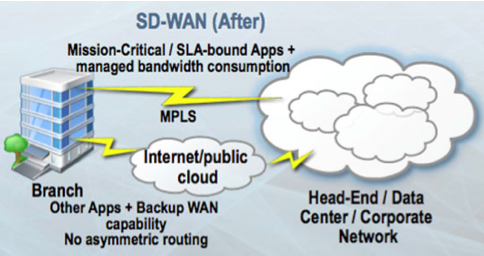Many businesses with multiple locations have traditionally networked them together with a solitary high-cost, low-speed MPLS or other dedicated circuit technology. This has continued despite the abundance of high-speed public Internet capabilities available.
To do this, organizations create a WAN, wide area network, to connect branch offices to a central corporate network or data centers separated by distance using technology that requires special proprietary hardware.
A movement to Software-Defined WAN, SD-WAN for short, seeks to shift more control over the network into the “cloud,” using a software approach. This technology is causing a major disruption to the telecommunications industry and will change how organizations think about – and pay for – their telecommunication lines.
This intelligent WAN technology is likely in your future. It allows organizations to pay a fraction of the cost for increased performance.
How does it improve performance?
With a software-defined WAN, an enterprise can rely more on public broadband and less on private links. Think of these lines like the type you would buy from your local ISP or agent. Public broadband circuits won't provide quality guarantees, so the SD-WAN will need to take measurements between locations to know whether the broadband link is capable of carrying traffic, like voice or video, reliably.

Software-defined networking creates a more efficient way to send and retrieve information between data centers or remote locations.
The technology has been available for a couple of years now, but is becoming more sought out as organizations operate more and more in virtual environments and rely on their Internet connectivity and performance to operate.
It allows organizations to buy two lines of Internet (ie: 100 MG each) and combine them to balance their loads – for half the cost.
What’s the real advantage?
The real advantage comes with the creation of a Managed WAN that manages the traffic intelligently, dynamically and even automatically based on a set of parameters. For example, when traffic reaches a certain volume threshold on a certain path (typically your primary), data can be automatically routed to the other line.
Today, most organizations only route traffic to the second line, seen as a back-up line, in the case of a failure. It’s a manual process.
The traditional model operates like a stop sign, with only a go or no go option. You see that it is either working or it is not.
A Managed SD-WAN is more like a stoplight. It adds a “yellow light” to allow you to receive alerts, identify issues and fix them before anything fails and you see a “red light.”
With the SD-WAN approach, organizations also can use multiple carriers for the lines. This provides further redundancy and improved performance for the organization. The downside is that the carriers will only “guarantee” a certain service level if you only use their lines – at the base cost reaching your desired service level guarantee is possible. It just costs more money.
So what’s the catch?
SD-WAN technology is not easy to implement. Making it all work together takes a significant amount of programming by a highly skilled IT professional and coordination with multiple vendors. It also requires an upfront investment in specialized hardware.
But when the adoption challenges are overcome, SD-WAN provides the ability to deliver more simplicity, automation and agility for businesses at a compelling cost. 